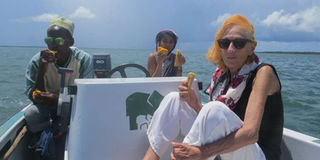The wonders of Pate Island

Sailing to Pate - Captain Lalli of KWS, Maya Mangat and Kiki Arts of Subira house, Lamu. PHOTO| RUPI MANGAT
What you need to know:
- We’re in the upper village — Pate Juu — walking through the narrow lanes and houses built of coral rag with new extensions in brick and cement.
- Children eye us curiously as men make haste to the mosque near the ancient crumbling graves scripted in Arabic.
- According to literature, Arabs settled here from 7th century. The Indians and the Chinese sailed in with their trading dhows and junks — some settled and married the local women.
- Strolling through the town, it’s interesting to see the descendants who call themselves Bajuni – some looking like Indians, some Arabic and some so fair.
We sail past a forest of the tallest mangrove trees that l’ve ever seen. Sparkling white sand bars appear in the low tide. It’s an endless blue planet from where we are when suddenly a dolphin slips in and out.
Towards midday, Captain Lalli stops to refuel. He also offers us juicy mangoes –talk of an impromptu picnic in the ocean.
Sailing on, he points to Faza, then Ndau – once powerful and independent sultanates on the Island of Pate. We pass a Kenya Navy patrol dinghy and then get off at Mtangawanda, a tiny ‘port’ named so because it has black sand on its shores.
Until recently, everyone sailed to Pate town through a narrow mangrove channel. Not anymore. Pate now boasts boda bodas and matatus. We bargain with the matatu driver – since there is no dhow coming in for the few hours – he has the upper hand. Sh5,000 for a return trip. We get him down to Sh2,000 and the 20-minute drive across the farms and salt pan gets us to the edge of the old sultanate of crumbling coral palaces, mosques and houses.
It’s surreal re-visiting five years later and walking through the ruins including Yumbe Palace, which is littered with trash.
THE FALL OF PATE
We’re in the upper village — Pate Juu — walking through the narrow lanes and houses built of coral rag with new extensions in brick and cement. Children eye us curiously as men make haste to the mosque near the ancient crumbling graves scripted in Arabic.
According to literature, Arabs settled here from 7th century. The Indians and the Chinese sailed in with their trading dhows and junks — some settled and married the local women. Strolling through the town, it’s interesting to see the descendants who call themselves Bajuni – some looking like Indians, some Arabic and some so fair.
By the 18th century, Pate was a thriving trading metropolis where silks were woven, goldsmiths made intricate jewellery and carpenters carved beautiful furniture including the musical siwa; two of which are in Lamu museum. The art of fine living was at its height with music and poetry written in the Kiamu dialect of Swahili in the royal palace of Yumbe. Mwana Kupona, Lamu’s famous poetess of the 19th century, hailed from here.
Infighting between the sultanates saw the fall of Pate – with the famous battle of Shela where the ruler of Pate who was aligned to the Omanis in Mombasa sailed to Shela on Lamu Island to conquer it. He misjudged the tide that left the army high and dry to be slaughtered by the Lamu folks.
Back to our expedition. We arrive at the lower end of Pate by the mangrove-lined creek with a few dhows anchored and children splashing around. Walking back, we reach the ‘Portuguese’ part – through narrow lanes again and stop at the house of Bwanamkuu Mohamed Hamdu. It’s a typical house – a single-storey house opening into a courtyard, and then the galleries for men, women and children. The woman of the house is at her sewing machine.
“The house is thought to be five centuries old,” he tells us. “The wooden bed is from India and also a few centuries old.” Two handsomely carved wooden chairs are placed by the column of the outer gallery.
Hamdu escorts us back to the waiting matatu and asks us to follow him to another ruin. “This is the grave of the seven virgins,” he says. “It’s sacred.”
The young man was part of the team that excavated part of the site led by a Swedish team of archaeologists. The story around the graves was of the time when the Portuguese invaded the island about seven centuries ago and went on a looting and raping rampage. The seven virgins committed suicide rather than be defiled.
“We found human bones. Upon being tested, they were found to be females. But we had to stop excavations because the elders forbade it.”
Back to the boat, we sail through a storm and halt to allow a gigantic Chinese barge sail in from the high seas and across Kilinana Channel, and on to the new Lamu port whose construction is ongoing. It’s a fast changing world.
Sail to Pate and on to Kiunga National Marine Reserve
Hire a speed boat– can cost anything upwards Sh10,000. Sailing in a local dhow is cheap. If you’re lucky and the wind is blowing in the right direction, it can take about three hours or more. Contact Kenya Wildlife Service (www.kws.go.ke) for advice. Most holiday homes and hotels can organise a day in Pate – and if you really want the isle feel, there are a few guesthouses. The heat can be killing – so be prepared.




